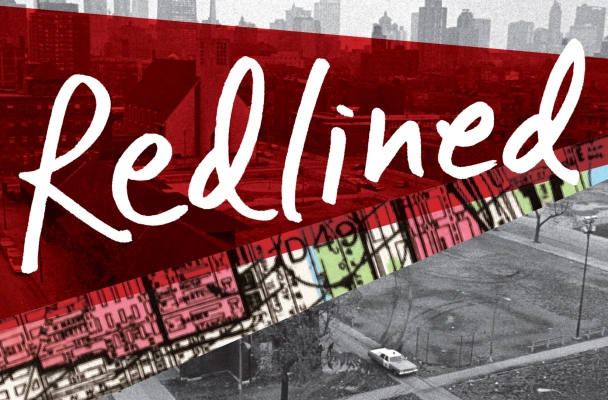Redlined – A fascinating first-person memoir of how a racist government policy affected West Garfield Park

A review by Bob Chiarito.
Fifty years after the West Side riots that started after the assassination of Martin Luther King, Jr., much of West Garfield Park has never recovered. But while the neighborhood’s challenges are often blamed on the riots of 1968, a new memoir shows that the neighborhood fell apart before that as the result of a government policy known as redlining.
Most books about Redlining – the government’s racist policy of not giving loans to anyone living in areas where blacks lived that started with The New Deal in 1930s and was enforced until being ruled illegal in 1968 – are academic in nature, filled with stats and charts and while sometimes informative, never get to the toll it took on those who lived through it. Until now. With her wonderfully insightful debut book, Redlined: A Memoir of Race, Change, and Fractured Community in 1960s Chicago, Linda Gartz tells the story of her white family and the effects redlining had on them and their neighborhood, Chicago’s West Garfield Park.
Gartz, an Emmy-Award winning television producer, told me in an interview that I did for Chicago Magazine recently that after her parents died, she discovered 25 bankers’ boxes filled with journals, letters and other mementos from her grandparents and parents, all of whom called West Garfield Park home.
Gartz calls on this material to get inside the thought process of her family, and does a fine job of it. It must have been a tall task to keep focus based on the amount of material that she had to sort through, but the book is all the better for its detail and depth. As the reader will discover, there are a lot of issues that impact the Gartz family, the mental illness of her grandmother; attitudes about pre-marital sex and women’s role in society; along with the focus of redlining and the changes in the neighborhood. At times, she seems to have gotten lost down a rabbit hole, focusing a bit too much on a family issue; but I’ll admit that’s a petty grievance.
For Gartz, who also grew up and remained in West Garfield Park until she was in college in the late 1960s, the story of her family could not be told without a large focus on redlining. Her parents owned and rented three buildings, including the one they lived in, so the affects of redlining threatened her family even more than most. As she points out, the fear of blacks moving into the neighborhood was based on more than racism. For the whites, the fear was that their property value would go down, which for the Gartz family, threatened their livelihood. That said, Gartz does not spare her family or sugar-coat things. Redlining may have caused whites to fear for their property values, but there was genuine racism from the neighborhood and her family. She writes about her mother telling a black woman who rings their doorbell to inquire about apartments that, “We do not rent to coloreds.”
Not long after redlining began in their neighborhood, the Gartz family would have to rent to blacks, as most of their white neighbors, including Gartz’s grandparents, had fled to the suburbs. Along the way, the Gartz family discovered that the only thing that changed was that they now had black neighbors, neighbors who they grew to love even more than their previous white neighbors.
Her parents were also unlike a lot of building owners, who packed up and moved out of the neighborhood and neglected their buildings. Her father’s job caused him to be on the road most of the time, so it was her mother who was largely responsible for the day to day upkeep of the buildings, which she took great pride in. Her mother was not a do-gooder per se, but did believe that if the buildings were kept in good shape the tenants would respect them, which they did. Perhaps reading this in 2018 sounds like that common sense, but it’s important to remember that many whites did not know enough in the mid-sixties to challenge common falsehoods. Gartz writes about how whites believed that once blacks moved into their neighborhood, the neighborhood often turned into a slum. But it was not the blacks who turned it into a slum, it was the landlords who neglected their buildings and a redlining system that forced blacks to be segregated to areas that couldn’t accommodate their growing numbers, often forcing several families into one apartment.
For whites, they were left with a neighborhood of declining property values and for those who stayed, most of their old friends and neighbors were gone. But they could leave. In fact, it was the FHA who underwrote what became known as “white flight,” giving loans by the thousands to those moving to the suburbs while areas like West Garfield Park became off limits to any mortgages. So, not only did the neighborhood the Gartz’s live for decades change racially, it changed economically and with that came crime. Add on the impact of the 1968 riots in which most of the business district of West Garfield Park and other West Side neighborhoods were destroyed; the crack cocaine problem of the 1980s and it’s not hard to see why the neighborhood has not been stabilized.
Redlined, if put in the right hands, would make a great movie. It’s a fascinating book and a much-needed look at how a national policy affected a specific Chicago neighborhood through the eyes of someone who lived through it. Hypothetically, it will be equally fascinating if 50 years from now, a book by a black resident who currently lives in West Garfield Park focuses on gentrification – perhaps the only hope residents have to cling to; for without serious governmental help, gentrification (another hot-button issue), may be the only thing that rids the neighborhood of the crime, poverty and open-air drug markets that can trace its roots directly back to redlining.


One Response to “Redlined – A fascinating first-person memoir of how a racist government policy affected West Garfield Park”
[…] For the full review, click here. […]